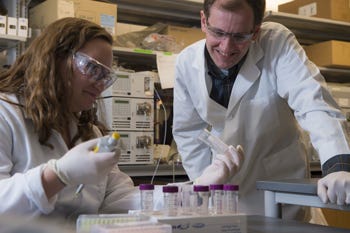Synthetic Collagen Fibers Could Revolutionize Tissue Engineering
November 3, 2014
Researchers at Rice University recently published a pair of papers detailing an advanced understanding of collagen fibers, and how they can self-assemble with their sticky ends. Further research could lead to better synthetic collagen for tissue engineering for both cosmetic and reconstructive medicine.
|
Rice University graduate student Katherine Jochim, left, and chemist Jeffrey Hartgerink demonstrated the self-assembly of standalone, sticky-ended triple helices that form collagen, the most common protein in mammals. (Credit: Jeff Fitlow/Rice University) |
Led by Jeffrey Hartgerink, the study has been looking into the details of how collagen begins as three distinct peptides that twist into characteristic triple helices, according to a recent Rice University news release. The group has already developed collagens for use as clotting agents, as well as scaffolding in regenerative medicine.
While a revolution in medical plastics may be just around the corner, Hartgerink's work could lead to several breakthroughs in tissue engineering. The two papers explaining the group's work were published in the Journal of the American Chemical Society, and explain precisely how mimetic peptides developed at the university may be aligned to form helices with sticky ends that will allow them to aggregate into fibers or gels. Hartgerink explained the discovery to Rice University news, and how his proposal was initially met with skepticism.
"We proposed in a Nature Chemistry paper (in 2011) that peptides self-assemble in an offset fashion that creates sticky ends," Hartgerink said. "Those sticky ends can then propagate. But even in the review of that paper, the mechanism took a fair amount of flak because there has been no reports in the literature that a collagen system could, in fact, create this offset."
Although it's taken a few years of hard work, along with his latest two papers detailing his research, Hartgerink finally feels like he's validated his proposal. His work showed that collagen forms from helical arrangements of three protein chains, also known as peptides. These chains, like all proteins, consist of amino acids like glycine and proline arranged in a certain order. Hartgerink can then design custom nanoscale chains by carefully arranging the amino acids and their positive and negative charges.
Once arranged in the right order, these charged amino acids cross-link into what Hartgerink calls axial salt bridges, or non-covalent bonds that hold the helices together with the help of stabilizing hydrogen bonds. From there the team works to define these axial charged pairs and utilize them to do different things. Understanding the fine details of collagen assembly presents the possibility of synthetic collagens for specific functions, Hartgerink said.
"A number of biomaterials use natural collagen, and there are advantages to replacing them with synthetic collagens," he said. "One of the main advantages is that we move away from health and regulatory problems associated with using animal sources."
Collagen is the most common protein found in mammals, and is a major component of bone and the fibrous tissues that support cells, and hold organs together. Despite being an incredibly important player in tissue behavior, Hartgerink believes some of the very basic ideas about collagen structure have eluded scientists for decades.
"I think the difficulty in understanding the mechanism is illustrated by the fact that it took two whole papers just to outline it," he said. "But these mechanistic studies will allow us to push the science forward and do more practical things."
While plenty of work still lies ahead, Hartgerink believes that synthetic collagen can help answer a lot of important questions surrounding its natural counterpart. The benefits of which could lead to exciting breakthroughs in tissue engineering and regenerative medicine for years to come.
Refresh your medical device industry knowledge at BIOMEDevice San Jose, December 3-4, 2014. |
Kristopher Sturgis is a contributor to Qmed and MPMN.
Like what you're reading? Subscribe to our daily e-newsletter.
About the Author(s)
You May Also Like



